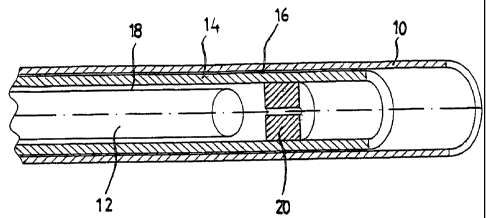Une partie des informations de ce site Web a été fournie par des sources externes. Le gouvernement du Canada n'assume aucune responsabilité concernant la précision, l'actualité ou la fiabilité des informations fournies par les sources externes. Les utilisateurs qui désirent employer cette information devraient consulter directement la source des informations. Le contenu fourni par les sources externes n'est pas assujetti aux exigences sur les langues officielles, la protection des renseignements personnels et l'accessibilité.
L'apparition de différences dans le texte et l'image des Revendications et de l'Abrégé dépend du moment auquel le document est publié. Les textes des Revendications et de l'Abrégé sont affichés :
| (12) Brevet: | (11) CA 2446446 |
|---|---|
| (54) Titre français: | PROCEDE ET DISPOSITIF POUR LA GENERATION D'OZONE |
| (54) Titre anglais: | METHOD AND DEVICE FOR GENERATING OZONE |
| Statut: | Réputé périmé |
| (51) Classification internationale des brevets (CIB): |
|
|---|---|
| (72) Inventeurs : |
|
| (73) Titulaires : |
|
| (71) Demandeurs : |
|
| (74) Agent: | RIDOUT & MAYBEE LLP |
| (74) Co-agent: | |
| (45) Délivré: | 2008-12-09 |
| (86) Date de dépôt PCT: | 2002-05-24 |
| (87) Mise à la disponibilité du public: | 2002-12-05 |
| Requête d'examen: | 2004-04-07 |
| Licence disponible: | S.O. |
| (25) Langue des documents déposés: | Anglais |
| Traité de coopération en matière de brevets (PCT): | Oui |
|---|---|
| (86) Numéro de la demande PCT: | PCT/DE2002/001890 |
| (87) Numéro de publication internationale PCT: | WO2002/096798 |
| (85) Entrée nationale: | 2003-11-05 |
| (30) Données de priorité de la demande: | ||||||
|---|---|---|---|---|---|---|
|
L'invention concerne un procédé pour la génération d'ozone à partir de gaz contenant de l'oxygène. L'ozone est généré par décharge électrique silencieuse dans un ensemble comprenant au moins deux entrefers traversés par le gaz et formés chacun entre une électrode et un diélectrique qui sépare l'entrefer correspondant d'une autre électrode. Selon l'invention, un étranglement du débit volumétrique du gaz d'au moins un entrefer est commandé.
The invention relates to a method for generating ozone from gases containing
oxygen. The ozone is generated by
silent electric discharge in an installation comprising at least two gaps,
which are traversed by the gas, each of said gaps being formed
between an electrode and a dielectric that separates each gap from an
additional electrode. According to the invention, the restriction
of the volumetric flow of the gas of at least one gap is controlled.
Note : Les revendications sont présentées dans la langue officielle dans laquelle elles ont été soumises.
Note : Les descriptions sont présentées dans la langue officielle dans laquelle elles ont été soumises.

Pour une meilleure compréhension de l'état de la demande ou brevet qui figure sur cette page, la rubrique Mise en garde , et les descriptions de Brevet , États administratifs , Taxes périodiques et Historique des paiements devraient être consultées.
| Titre | Date |
|---|---|
| Date de délivrance prévu | 2008-12-09 |
| (86) Date de dépôt PCT | 2002-05-24 |
| (87) Date de publication PCT | 2002-12-05 |
| (85) Entrée nationale | 2003-11-05 |
| Requête d'examen | 2004-04-07 |
| (45) Délivré | 2008-12-09 |
| Réputé périmé | 2016-05-24 |
Il n'y a pas d'historique d'abandonnement
Les titulaires actuels et antérieures au dossier sont affichés en ordre alphabétique.
| Titulaires actuels au dossier |
|---|
| WEDECO GESELLSCHAFT FUR UMWELTTECHNOLOGIE MBH |
| Titulaires antérieures au dossier |
|---|
| BILLING, ERNST MARTIN |
| FIEKENS, RALF |
| HOFER, UWE |